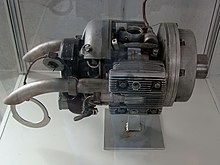Junkers engine
Jumo 004 Turbojet
Type Turbojet
National origin Germany
Manufacturer Junkers
First run 1940
Major applications Arado Ar 234 / Messerschmitt Me 262
.
History Junkers Flugzeug- und Motorenwerke AG JFM
Junkers Jumo 004 was the world's
first production turbojet engine

The Junkers Jumo 004 was the world's first production turbojet engine in operational use, and the first successful axial compressor turbojet engine. Some 8,000 units were manufactured by Junkers in Germany late in World War II, powering the Messerschmitt Me 262 fighter and the Arado Ar 234 reconnaissance/bomber, along with prototypes, including the Horten Ho 229. Variants and copies of the engine were produced in Eastern Europe and the USSR for several years following the end of WWII
The feasibility of jet propulsion had been demonstrated in Germany in early 1937 by Hans von Ohain working with the Heinkel company. Most of the Reich Air Ministry (RLM) remained uninterested, but Helmut Schelp and Hans Mauch saw the potential of the concept and encouraged Germany's aero engine manufacturers to begin their own programmes of jet engine development. The companies remained skeptical and little new development was carried out.
Technical description and testing


The first prototype 004A, which used diesel fuel, was first tested in October 1940, though without an exhaust nozzle. It was bench-tested at the end of January 1941 to a maximum thrust of 430 kgf (4,200 N; 950 lbf), and work continued to increase the thrust, the RLM contract having set a minimum of 600 kgf (5,900 N; 1,300 lbf) thrust.
Vibration problems with the compressor stators, originally cantilevered from the outside, delayed the program at this point. Max Bentele, as an Air Ministry consulting engineer with a background in turbocharger vibrations, assisted in solving the problem. The original aluminium stators were replaced with steel ones in which configuration the engine developed 5.9 kN (1,300 lbf) in August, and passed a 10-hour endurance run at 9.8 kN (2,200 lbf) in December. The first flight test took place on March 15, 1942, when a 004A was carried aloft by a Messerschmitt Bf 110 to run up the engine in flight. The 004 used an eight-stage axial-flow compressor, with six straight-through combustion chambers (made from sheet steel), and a one-stage turbine with hollow blades
0
KnTrust
0
Stageaxial compressor
0
KgWeight
Inch
MtrLength
Photo Gallery
Junkers Flugzeug- und Motorenwerke AG JFM
Junkers Jumo 004 was the world's first production turbojet engine


Junkers Jumo 004 was the world's first production turbojet engine
General characteristics
-
-
-
- Type: Turbojet
- Length: 3.86 m (152 in)
- Diameter: 81 cm (32 in)
- Dry weight: 719 kg (1,585 lb)
-
-
Performance
-
Performance
- Maximum thrust: 8.8 kN (1,980 lbf) at 8,700 rpm
- Overall pressure ratio: 3.14:1
- Thrust-to-weight ratio: 1.25
Comparable Engines
-
-
- Armstrong Siddeley ASX
- BMW 003
- Heinkel HeS 011
- Ishikawajima Ne-20
- Lockheed J37 – first American axial-flow jet engine design attempt
- Metropolitan-Vickers F.2
- Westinghouse J30 – first operable American axial-flow jet engine (1943)
-
.
Links to Youtube & Others
During its service with Luft Hansa, the Ju 52 had proved to be an extremely reliable passenger airplane. This positive experience contributed to its adoption by the Luftwaffe as a standard aircraft model.
Junkers Ju 52/3m
"Aunt Ju"
Lightly armed, and with a top speed of only 265 km/h (165 mph) — half that of a contemporary Hurricane — the Ju 52 was very vulnerable
Youtube Link
The Colombian Air Force used three Ju 52/3mde bombers equipped as floatplanes during the Colombia-Peru War in 1932–1933.












